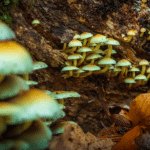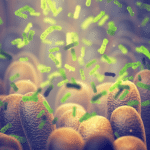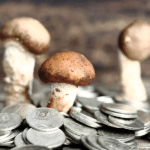In a shorthand that drives scientists mad, serotonin is often called ‘the neurotransmitter of happiness.’ This tag is especially troublesome as more and more flaws become apparent in the ‘serotonin hypothesis’ of depression – the idea that depression is caused by a serotonin deficit, which a pill (a serotonin reuptake inhibitor) could correct.1
Serotonin is a complex molecule in the brain and the periphery with a vast and intricate receptor system classified into seven main subtypes that regulate a wide array of physiological functions. Calling serotonin the happiness molecule is short shrift.
The importance of serotonin transcends happy mind states. Conserved as an evolutionary through-line in all bilateral animals, including worms and insects, the serotonin molecule modulates the release of a swathe of other neurotransmitters.2 Serotonin (which is often abbreviated as 5-HT because of its proper chemical name 5-hydroxytryptamine) is involved in behaviors as diverse as aggression, learning, appetite, sleep, cognition, and reward activity. The receptors for serotonin have become pharmaceutical targets for a range of neuropsychiatric disorders and gut-related conditions. Ninety percent of 5-HT is located in the GI tract, where it regulates intestinal motility.
Biochemist Maurice Rapport isolated serotonin and elucidated its molecular structure in the late 1940s. Two distinct serotonin receptor binding sites – 5-HT1 and 5-HT2 (later renamed 5-HT1A and 5-HT2A) – were identified in the rat brain in 1979. It turns out that cannabidiol (CBD), a promiscuous, non-intoxicating cannabis compound, binds directly to both of these receptors.
Whereas CBD has little binding affinity for the classical cannabinoid receptors, CB1 and CB2, several serotonin receptor subtypes are key docking sites for CBD. The 5-HT2A receptor also mediates the actions of LSD, mescaline, and other hallucinogenic drugs. But CBD and LSD act at 5-HT2A, the psychedelic receptor, in different ways, resulting in markedly different effects.
Receptor Complexes
Reported initially in 2005, the discovery that CBD interacts directly with these (and other) 5-HT receptors hints at a broader relationship between the endocannabinoid and serotonergic systems that scientists are still uncovering. Endogenous cannabinoids and serotonin are both well-conserved across animal taxa and both link to an extensive “super family” of G-protein coupled receptors in the brain and the periphery. Furthermore, there is considerable communication between these two neurotransmitter systems, which are involved in similar physiological functions throughout the body, such as the relief of anxiety, the reduction of pain, the alleviation of nausea and headaches, and the regulation of internal temperature.
Embedded on the surface of cells, G-protein coupled receptors are so complicated that the study of their signaling pathways has already yielded a half dozen Nobel Prizes for figuring out various parts of the picture. The activation of a G-protein coupled receptor from a signal outside the cell releases a second messenger molecule into the cell’s interior. These intracellular molecules act as Western Union messengers that telegraph signals all over the cell. Their primacy in human health is demonstrated by the fact that roughly half of all modern pharmaceuticals target a G-protein coupled receptor.
It used to be thought that G-protein coupled receptors worked as solo actors – until scientists learned that these transmembrane-bound proteins can link up and “dimerize” into receptor complexes with novel signaling. (A “dimer” is a chemical structure formed when two of those receptors floating around the lipid membrane join together into a functional unit.) The first breakthrough came in 2002 when researchers at the University of Washington in Seattle reported that CB1 cannabinoid receptors sometimes become entangled and form “homomeric” complexes with themselves.
We still don’t fully understand the physiological consequences of receptor dimerization, but this much is evident: Different types of receptors can intertwine and dimerize with each other. According to a 2013 study by Spanish scientists investigating ischemia (an injury that causes interrupted blood flow) in newborn piglets, neuroprotective effects were mediated by a 5-HT1A serotonin receptor conjoined to CB2 cannabinoid receptor in a “heteromer” complex. That’s where two different receptor types meld together and often perform actions that neither of them does on their own.
Cross-Talk
There is extensive cross-talk and feedback between the endocannabinoid and serotonergic systems. Anandamide, an endogenous cannabinoid compound, shows activity at 5-HT1A. So does CBD, which has been described as “a modest affinity agonist at the human 5-HT1A receptor.”
An agonist activates a receptor; an antagonist blocks a receptor. CBDA, the unheated “acid” version of cannabidiol that exists in the raw plant, is a more potent 5-HT1A agonist than CBD. CBDA shows great promise as an anti-emetic and as a treatment for anticipatory nausea.
When injected into several brain structures, CBD facilitates 5-HT1A-mediated neurotransmission. CBD activation of the 5-HT1A receptor has been shown to decrease blood pressure, lower body temperature, slow the heart rate, and lessen pain. In 2013, the British Journal of Pharmacology reported that 5HT1A mediates CBD’s helpful effects in animal models of liver damage, anxiety, depression, pain and nausea.
CB1 cannabinoid receptors – which are activated by THC, not CBD – are the most prevalent G-protein coupled receptors in the central nervous system. CB1 receptors are found in many brain regions, including the dorsal raphe nucleus, which is also the primary source of serotonin in the forebrain. In animal models, stimulating these serotonergic neurons lowers anxiety and fights depression. Inhibiting them causes depressive states.
Mice genetically engineered to not express CB1 in this serotonin-producing region of the brain were found to be more anxious than their wild type counterparts.
Long-term cannabinoid activation downregulates 5-HT1A receptors, according to a 2006 article by Matthew Hill, et al, in the International Journal of Neuropsychopharmacology. Another study listed several conditions where by blocking the serotonin receptors, a reduction occurred in various cannabinoids effects such “as the conditioning of fear memory, emotional memory consolidation, antinociception [painkilling], catalepsy, hypothermia [and] the activation of the hypothalamic-pituitary-adrenal axis in rodents.”3
5-HT2A: Tripping & Forgetting
CBD is also active at the 5-HT2A receptor, but apparently less so compared to CBD’s binding affinity for 5-HT1A.
5-HT2A activity has been linked to various phenomena, such as headaches, mood disorders, and hallucinations. This serotonin receptor subtype is known for its importance to the psychedelic experience. LSD, mescaline, and components of the psilocybin mushroom are potent agonists that bind to 5-HT2A – and when that happens get ready for the magical mystery tour.
It’s worth noting that oral consumption of a high dose of cannabis resin (hashish) can trigger LSD-like effects, including vivid, kaleidoscopic hallucinations. Indeed, there “is an outstanding body of experimental evidence,” according to Dr. Ethan Russo, “to suggest that THC is hallucinogenic while the closely related cannabinoid, cannabidiol (CBD) opposes such activity.”
Could it be that the 5-HT2A receptor mediates the hallucinogenic properties of THC? Unlike CBD, THC does not bind directly to 5-HT2A. But, as noted earlier, THC directly activates the CB1 cannabinoid receptor. And we know from a remarkable paper published by PLoS Biology in 2015 that CB1 receptors form heterodimer complexes with 5-HT2A receptors. This means that CB1 and 5-HT2A receptors can entwine and function as a combined entity.
Intriguingly, these receptors working together activate signaling pathways that neither of them cause on their own. Whether this can account for the hallucinogenic effects of high-dose cannabis concentrates remains a matter of speculation. But we know from behavioral studies on mice that CB1/5-HT2A heteromer complexes mediate both the positive painkilling benefits of THC, as well as THC’s amnesiac effects. [4]
Specifically, the PLOS Biology study found these cannabinoid/serotonin heteromers are “expressed and functionally active in specific brain regions involved in memory impairment.” A subsequent report in Molecular Neurobiology attributed the upregulation of CB1/5-HT2A heteromer complexes in human olfactory cells to chronic cannabis consumption.
Some cannabis proponents might bristle at the allegation that chronic use of their favorite herb causes short-term memory loss, but it’s hard to argue with the scientific evidence: In mice and in humans, cannabis generally makes it more difficult to remember, for example, the details of a movie quite as well or, with respect to rodents, to navigate a maze quite as quickly.
But THC’s impact on memory isn’t necessarily detrimental. In fact, far from being an impairment, forgetting can be one of marijuana’s most important therapeutic aspects. Cannabinoids might be just the thing to help a veteran forget a triggering event or at least lower the stranglehold of that memory.
It seems that these heteromer complexes mediate some of the cognitive deficits attributed to THC as well as its benefits.
CBD, THC & 5-HT3A
The 5-HT3A receptor warrants at least a brief mention because it is unique among serotonin receptors. Unlike all the other serotonin receptor subtypes, 5-HT3A is not a G-protein coupled receptor. Instead, 5-HT3A functions as an ion channel.
An ion channel regulates the flow of ions across the cell membrane and thus helps to regulate the rapid electrical signals used by the brain.
Located in the periphery as well as the central nervous system, 5-HT3A receptors are involved in mood disorders, as well as the transmission of pain signals. Antagonistic drugs that block the 5-HT3A receptor are used for treating chemotherapy-induced nausea and vomiting.
Both THC and CBD are potent negative allosteric modulators of 5-HT3A receptors. This means that THC and CBD interact with the 5-HT3A receptor in a way that changes its conformation, or shape, so that the receptor is less likely to bind efficiently with and be activated by its native ligand, serotonin.
This might account for some of the anti-nausea effects of THC and CBD. Intriguingly, anandamide, the native cannabinoid, also causes this kind of inhibition. Plant cannabinoids and endogenous cannabinoids work in tandem with the serotonin system to help ease yet another human ailment.
Lex Pelger writes articles about psychoactives and the endocannabinoid system. He publishes a weekly cannabinoid science newsletter Cannabinoids & the People and conducts 1-on-1 education sessions on using CBD, PEA, THC & CBDA for serious health conditions. © Copyright, Project CBD. May not be reprinted without permission.
Footnotes
- By blocking the reuptake of serotonin, SSRIs (selective serotonin reuptake inhibitors) increase the concentration of 5HT in the synaptic cleft between nerve cells and consequent neuronal activity. But chronic use of certain SSRIs have been shown to lower the baseline level of endogenous serotonin.
- Known to regulate behavioral aging and longevity in the primitive nematode, serotonin functions as a neurotransmitter in the nervous system of most animals. Concentrations of serotonin are found in insect venom as well as in various fungi and fruits, including plums, kiwi, banana, pineapple, plantains and tomatoes.
- There’s a lot that scientists still don’t understand about how and when the cannabinoids modulate serotonin release. Many variables come into play. Some 5-HT receptor subtypes transmit an inhibitory signal; other 5-HT subtypes convey an excitatory signal. Cannabinoid receptors also function in a bidirectional manner, causing both neuronal excitation and inhibition by acting on glutamate and GABA neurotransmitters, respectively. And the biphasic properties of cannabinoids, whereby low and high dosages result in opposite effects, is another confounding factor. Some research indicates that THC decreases serotonin production via the CB1 receptor. But several other studies arrive at confusing conclusions about what exactly is happening with CB1 receptors and serotonin in the dorsal raphae nucleus. There’s no simple correlation: the endocannabinoid tone of the area, the strength of the synapse and the density of the CB1 receptors all affect whether CB1 activation will cause serotonergic neurons to fire or be inhibited. As is often true with these nuanced systems, there’s not a simple off-and-on switch but a variable and complex feedback mechanism at work.
- Adrian Devitt-Lee adds: “Dimerization, in fact, may be the key to understanding why some of the chemicals that activate 5-HT2A aren’t psychedelic (such as serotonin itself). Some research suggests that hallucinogens like LSD cause 5-HT2A to dimerize with mGlu2, a G-protein coupled receptor which responds to the neurotransmitter glutamate. On the other hand, serotonin and other non-hallucinogenic molecules would activate 5-HT2A without causing it to dimerize. This hypothesis, however, is based on computer simulations and needs more evidence.”
Sources
- Elphick MR, Egertová M. The neurobiology and evolution of cannabinoid signalling. Philos Trans R Soc Lond B Biol Sci. 2001 Mar 29;356(1407):381-408.
- Fernández-Ruiz J, Sagredo O, Pazos MR, García C, Pertwee R, Mechoulam R, Martínez-Orgado J. Cannabidiol for neurodegenerative disorders: important new clinical applications for this phytocannabinoid?. Br J Clin Pharmacol. 2013 Feb;75(2):323-33.
- Franklin JM, Carrasco GA. Cannabinoid receptor agonists upregulate and enhance serotonin 2A (5-HT(2A)) receptor activity via ERK1/2 signaling. Synapse. 2013 Mar;67(3):145-59.
- Galindo L, Moreno E, López-Armenta F, Guinart D, Cuenca-Royo A, et al. Cannabis Users Show Enhanced Expression of CB1–5HT2A Receptor Heteromers in Olfactory Neuroepithelium Cells. Mol Neurobiol. 2018 Jan 2.
- Geddes SD, Assadzada S, Lemelin D, Sokolovski A, Bergeron R, et al. Target-specific modulation of the descending prefrontal cortex inputs to the dorsal raphe nucleus by cannabinoids. Proc Natl Acad Sci U S A. 2016 May 10;113(19):5429-34. PubMed PMID: 27114535.
- Haj-Dahmane S, Shen RY. Endocannabinoids suppress excitatory synaptic transmission to dorsal raphe serotonin neurons through the activation of presynaptic CB1 receptors. J Pharmacol Exp Ther. 2009 Oct;331(1):186-96.
- Häring M, Marsicano G, Lutz B, Monory K. Identification of the cannabinoid receptor type 1 in serotonergic cells of raphe nuclei in mice. Neuroscience. 2007 May 25;146(3):1212-9.
- Hill MN, Sun JC, Tse MT, Gorzalka BB. Altered responsiveness of serotonin receptor subtypes following long-term cannabinoid treatment. Int J Neuropsychopharmacol. 2006 Jun;9(3):277-86.
- Mendiguren A, Aostri E, Pineda J. Regulation of noradrenergic and serotonergic systems by cannabinoids: relevance to cannabinoid-induced effects. Life Sci. 2018 Jan 1;192:115-127.
- Moranta D, Esteban S, García-Sevilla JA. Differential effects of acute cannabinoid drug treatment, mediated by CB1 receptors, on the in vivo activity of tyrosine and tryptophan hydroxylase in the rat brain. Naunyn Schmiedebergs Arch Pharmacol. 2004 May;369(5):516-24.
- Pazos MR, Mohammed N, Lafuente H, Santos M, Martínez-Pinilla E, et al. Mechanisms of cannabidiol neuroprotection in hypoxic-ischemic newborn pigs: role of 5HT(1A) and CB2 receptors. Neuropharmacology. 2013 Aug;71:282-91.
- Piñeyro G, Blier P. Autoregulation of serotonin neurons: role in antidepressant drug action. Pharmacol Rev. 1999 Sep;51(3):533-91.
- Russo EB, Burnett A, Hall B, Parker KK. Agonistic properties of cannabidiol at 5-HT1a receptors. Neurochem Res. 2005 Aug;30(8):1037-43.
- Viñals X, Moreno E, Lanfumey L, Cordomí A, Pastor A, et al. Cognitive Impairment Induced by Delta9-tetrahydrocannabinol Occurs through Heteromers between Cannabinoid CB1 and Serotonin 5-HT2A Receptors. PLoS Biol. 2015 Jul;13(7):e1002194.
- Wager-Miller J, Westenbroek R, Mackie K. Dimerization of G protein-coupled receptors: CB1 cannabinoid receptors as an example. Chem Phys Lipids. 2002 Dec 31;121(1-2):83-9.







